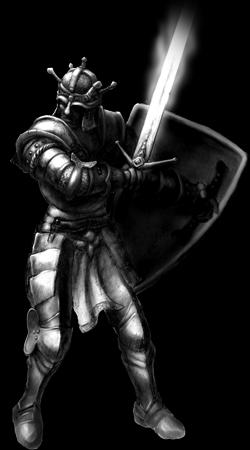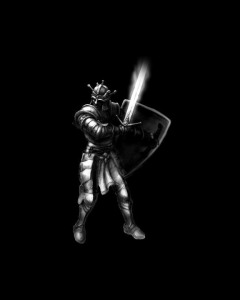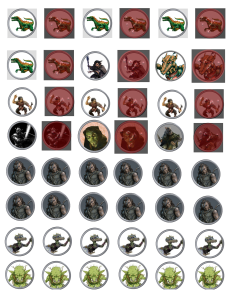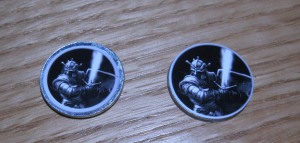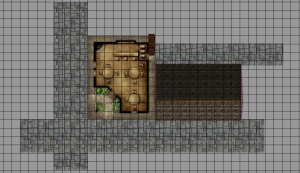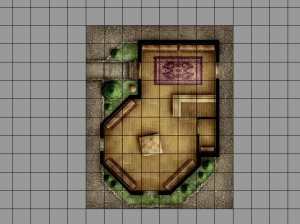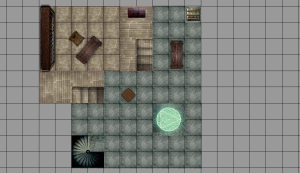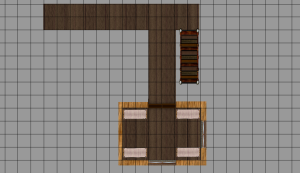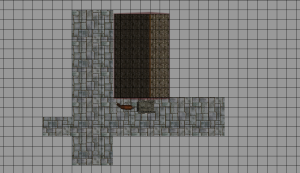While I mainly use this blog to talk about my efforts at serving as a Dungeon Master for my own online games of D&D, I do like to play D&D, too. At the moment I am between campaigns in real life. I don’t mean that I have no prospects for my next campaign – the next one will start in a couple of weeks with my same play group, just with a different person taking a turn as DM (as I discussed in my post about the death of my wizard character, Zod). The online game that I DM is also on hiatus as two of the three players are currently on vacation. This has given me lots of time to learn about MapTool, for instance, which is great – but I miss playing D&D.
Fortunately for me, I live within walking distance of a fantastic local game store called Enchanted Grounds. This is a game store / coffeehouse. I mainly go for the games – formerly a lot of Magic: The Gathering and German-style board games like Pandemic and Settlers of Catan, and more recently of course for Dungeons and Dragons books and dice. In addition to selling D&D stuff, Enchanted Grounds also runs organized D&D events. They’ve been running D&D Encounters on Wednesday nights, which I’d love to check out but which unfortunately conflicts with the bowling league that Barbara and I are in (yes, we both play D&D and bowl). They also have Living Forgotten Realms, or LFR, which I only vaguely understood. I knew it was a D&D Fourth Edition game, but it’s set in a campaign world that I know nothing about. Also, I wasn’t sure about the rules for creating a character, getting into a game, etc. When I finished work Thursday evening, I had a hankering to play some D&D, so I printed out the character sheet for one of the three potential characters I had rolled up for the campaign that we’ll be starting with our friends in a couple of weeks (a character that I was pretty sure I was not going to play in that campaign) and headed off to the store.
I had checked the store’s web site and their LFR Yahoo Group before leaving, and I knew that players had to basically reserve their spots in the game in advance. There were going to be two tables of players – one in an adventure for level 4-7 characters and one for level 1-4 characters. I introduced myself to Rich, the man who coordinates the LFR games at Enchanted Grounds, and said that I had never played LFR before and would be watching and learning this evening. However, when game time rolled around, one of the six seats at the low-level game table was empty because one of the scheduled players hadn’t shown up. Lucky me – I would get to play!
I introduced myself and my character (Rohgar, the half-elf Paladin) to the group, and we were on our way. The group had five first-level characters and one second-level. We were a technically balanced party, though a little heavy on healing. My Paladin was the only defender, and he was a healing-focused guy. We also had two Clerics, one of which was a mega-healing pacifist. We had a controller – a Psion, which I hadn’t seen in action before – and two strikers (a Ranger and an Avenger).
The adventure began with the local king charging our group with the task of investigating some evil activities in the area around the city, and we soon encountered an old man with a broken cart by the side of the road. As we approached to help him, some shadow creatures came out of the trees and attacked us. We beat them up without much trouble, fixed the man’s cart, then headed off in pursuit of a black-clad knight we had seen on a nearby ridge during the battle.
From here, the night turned into a long stretch of role playing, which was kind of fun (though mixing in a combat encounter along the way might have been more fun). We were on horses and had to follow the knight’s trail down a steep slope, which was problematic for me as I was terrible at Athletics. Most of us ended up breaking our horses’ legs in the descent (so sorry, Starshine!) and had to continue on foot. We found the knight, who had a skull for a face, in a glade of white-painted trees, which a Religion check revealed were designed to ward off evil spirits. We talked to the knight instead of attacking, and it turned out that he was a guy from town who had been falsely accused of treason, cursed by his father, and banished from the city. The skull face was just a mask he used to hide his identity from the townsfolk who hated him (smart choice, going with a skull face). We wanted to help him clear his name, so we took him back to town with us.
We arrived to find a big, torch-wielding mob freaking out about the evil activities and the approaching (unscheduled) lunar eclipse. Our knight friend skedaddled. We dispersed the crowd, repaired a holy obelisk, talked to the knight’s father (who definitely seemed fishy to us), tracked town the town official who had banished the knight (he was incompetent), tracked down some reports about the evil activities that the town official had hidden (they would help to clear the knight’s name) and finally ended up at a temple to an evil goddess. The cult leader, naturally, was the knight’s father. We dispersed the cultists and engaged the leader, who was about to sacrifice his baby son on the altar. Our strikers teamed up on the cult leader while the rest of us handled the shadow creatures that were trying to get into the temple. Again, it was a fairly easy combat. We saved the baby, got a new hearing for the knight (I’m sure he’ll win) and were awarded the king’s favor.
My verdict on Living Forgotten Realms as a player is that it’s definitely a way to get that D&D fix when I can’t get it any other way. I believe this store runs games three times a week, so there are plenty of opportunities to play if I so desire. I was surprised at the low level of challenge in the battles, but the role playing was quite fun. Our pacifist Cleric basically stood up and gave a fire-and-brimstone speech to the mob in the city, which had the odd effect of convincing the townsfolk to try to incinerate their lamps, but it was way cool. My Paladin was supposed to be quite diplomatic, but I sort of stunk when it came to actually talking rather than rolling dice. I’ll work on it, though. I definitely prefer the home games with friends, but LFR is something I could see myself playing from time to time.
The magic item system for LFR is a little confusing. During the adventure we came across a few different magic items, and we had to divvy them up for use during the adventure. However, at the END of the adventure we could each take one magic item, and multiple players could pick the same thing. To make matters more complicated, you can only USE a magic item up to four levels higher than your character (so, as a first-level character I could use up to a fifth-level magic item), but you can HAVE any level magic item. Also, if it’s an enchanted weapon of a particular type, you can transfer the enchantment to any weapon you want. In my Paladin’s case, I took a seventh-level magical dagger and transferred its enchantment to my longsword, but I can’t actually use that enchantment until I move up to level three. Confusing, I know.
I could see myself playing LFR again in the future – hopefully with Barbara joining me – but I’m pretty sure I don’t want to play my Paladin again. He did exactly what he was supposed to do – bring the enemies to himself, absorb damage, dish out healing, punish the enemies he calls out when they attack his allies – but it just wasn’t that much fun. I really didn’t move around at all in either battle – I stood there and traded blows with bad guys. It worked for the party, but it was kind of dull. I know I’m going to play an Avenger in my main campaign with my friends, so I might try LFR again with a Warlord that I’ve rolled up. We shall see.
How about DM lessons? Aarrun, the DM for the game Thursday night, was a great DM in my opinion, and I feel like I could learn a lot from him.
- He knew the rules forward and backward. For instance, he knew what my Paladin’s powers could do much better than I did.
- He kept the game moving, letting the table know whose turn it was and who would be up next.
- He got into the role playing in a good way. He had a favorite NPC – a batty old lady who ran a book and bird shop – who really came alive with Aarrun’s acting.
- He let the players try whatever they wanted, even if it was stupid. Hilarity often ensued.
I have a long way to go before I can be a DM on par with Aarrun, but I feel like I can get there one day.



